Black August 2020
SUNDAY
MONDAY
TUESDAY
WEDNESDAY
THURSDAY
FRIDAY
SATURDAY






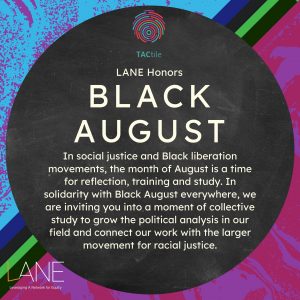

Aug 1 (1 of 2)
In social justice and Black liberation movements, the month of August is a time for reflection, training, and study. In solidarity with Black August everywhere, LANE is inviting you into a moment of collective study to grow the political analysis in our field and connect our work with the larger movement for racial justice.

Aug 1 (2 of 2)
As Cohort members of Leveraging a Network for Equity (LANE), we have been on a four-year journey together to redress the historic devaluation of arts organizations of color and white supremacist practices in our field.
We will be sharing a month of prompts, links, quotes from Cohort members, and readings, based not on what we think you should do but based on what we have been doing. We offer these thoughts and concepts as tools for us to navigate these difficult times and align our work for a more just world.


Aug 2 (1 of 1)
“One of the tasks of any revolutionary movement is to turn thinkers into fighters and fighters into thinkers.”
—General Baker
www.jacobinmag.com/2014/05/detroit-s-radical-general-baker/


Aug 3 (1 of 3)
What is Black August?
Black August is a monthlong dedication to honoring Black history, especially radical Black history and the ongoing fight against the carceral state. It is a time to be reflective and study, to prepare ourselves for what a struggle for liberation requires.

Aug 3 (2 of 3)
Leveraging a Network for Equity (LANE) has been in a four-year process of learning and growing. As Black August is a time of training, realignment, and preparation, we are offering this series to invite others along our learning journey towards justice and liberation.

Aug 3 (3 of 3)
Learn more about Black August:
Celebrate Black August – Critical Resistance
For over ten years, SpiritHouse Inc has commemorated the month of Black August through a daily practice of haiku poetry writing through their Black August 575 Project


Aug 4 (1 of 3)
Every Tuesday of Black August, we will feature one of the Cornerstones of LANE. The Cornerstones are the guiding principles that frame and shape how the work of shifting towards an arts culture of justice and equity happens.
Emergence is the way complex systems and patterns arise out of a multiplicity of relatively simple interactions. Through our Cornerstone of Emergence, we:
- Engage complexity to find sustainable strategies
- Work with a sense of scale to impact individuals, organizations, and networks
- Recognize the importance of systems thinking

Aug 4 (2 of 3)
“Transformation doesn't happen in a linear way, at least not one we can always track. It happens in cycles, convergences, explosions. If we release the framework of failure, we can realize that we are in iterative cycles, and we can keep asking ourselves–how do I learn from this?”
—adrienne maree brown

Aug 4 (3 of 3)
Check out the linked resources, including Sage Crump and adrienne maree brown’s conversation about LANE’s Cornerstone Emergence on TACtile, a podcast created by the LANE community that discusses tools and concepts designed to transform the arts and culture sectors towards equity and justice.


Aug 5 (1 of 4)
“We essentially shifted from the approach of a sprinter to that of a marathon runner.”
—Tara Dalbo, Deputy Director, La Peña Cultural Center
Graphic recordings developed at LANE gatherings by drawnversation

Aug 4 (2 of 4)
“When I think of LANE...I think of two concepts: that of greater ecosystems and the relationship of the micro + macro. LANE taught us to zoom out, to understand the greater ecosystem within which we are working, both organizationally and systemically. LANE's teachings... guided us to comprehensively scrutinize the nature of our programs, function, mission, values and financial state. It encouraged us to make decisions that were, as a result of this work, informed, thoughtful, long-term and strategic interweaving health and sustainability for staff and board alike. We essentially shifted from the approach of a sprinter to that of a marathon runner. I feel that this touched the entirety of the cohort and I believe that this work has the ability to foster a greater movement, going so far as to influence or create much needed systemic change within our broader arts nonprofit ecosystem.”
—Tara Dalbo, Deputy Director; La Peña Cultural Center

Aug 5 (3 of 4)
How does emergence apply to your inner and outer work of transformation?
What are your practices of systems thinking and emergence?

Aug 5 (4 of 4)
For more exploration on ecosystems and the relationship between micro and macro visit these links:
- Fractals: The Relationship Between Small and Large, Earthling Opinion Blog, adrienne maree brown
- Building a Stronger ALAANA Arts Community: Keeping an Eye on Systems- Grantmakers in the Arts, Janet Brown and Angelique Power
- Practicing the Elements of a Liberating Ecosystem


Aug 6 (1 of 4)
Graphic recordings developed at LANE gatherings by drawnversation

Aug 6 (2 of 4)
“Art helps understand facing fear, like with falling exercises as a dancer. There's an art to messing up and coming out of it. It's not just an analogy, it actually is something physically that I've found that has helped me move through some of these things.”
—Stephanie McKee, Executive Artistic Director, Junebug Productions

Aug 6 (3 of 4)
How does your artistic practice inform your organizational infrastructure?

Aug 6 (4 of 4)
“If what we need to dream, to move our spirits most deeply and directly toward and through promise, is a luxury, then we have given up the core—the fountain—of our power, our womanness; we have given up the future of our worlds.”
—Audre Lorde, “Poetry Is Not a Luxury” (1985)


Aug 7 (1 of 4)
Graphic recordings developed at LANE gatherings by drawnversation

Aug 7 (2 of 4)
“Never saw myself as an ED of an arts organization. Figuring out how to navigate what it takes to be a strong ED of an org. I had to grow to become the director of the newly envisioned Myrna Loy, growing as a person, artist, leader, collaborator. What do I need to do in my humanity to become a leader of the present organization.”
—Krys Holmes, Executive Director, The Myrna Loy

Aug 7 (3 of 4)
What kind of leader do you need to grow into for your organization in this moment?

Aug 7 (4 of 4)
- Nonprofit AF by Vu Le
A blog exploring the fun and frustrations of nonprofit work - Cultivating Leaderful Ecosystems
by Aja Couchois Duncan, Susan Misra and Vincent Pan
at Nonprofit Quarterly


Aug 8 (1 of 1)
“True systems change efforts do not merely change inequitable structures, but strive to transform the underlying power dynamics, narratives, and histories that built these structures and enable them to thrive. An equity lens is essential to systems change efforts to avoid change efforts that reinstitute the status quo or replace one systemic inequity with another.”
—From “Practicing the Elements of a Liberating Ecosystem,” Change Elemental


Aug 9 (1 of 1)
“History is not the past. It is the stories we tell about the past. How we tell these stories—triumphantly or self-critically, metaphysically or dialectically—has a lot to do with whether we cut short or advance our evolution as human beings.”
—Grace Lee Boggs

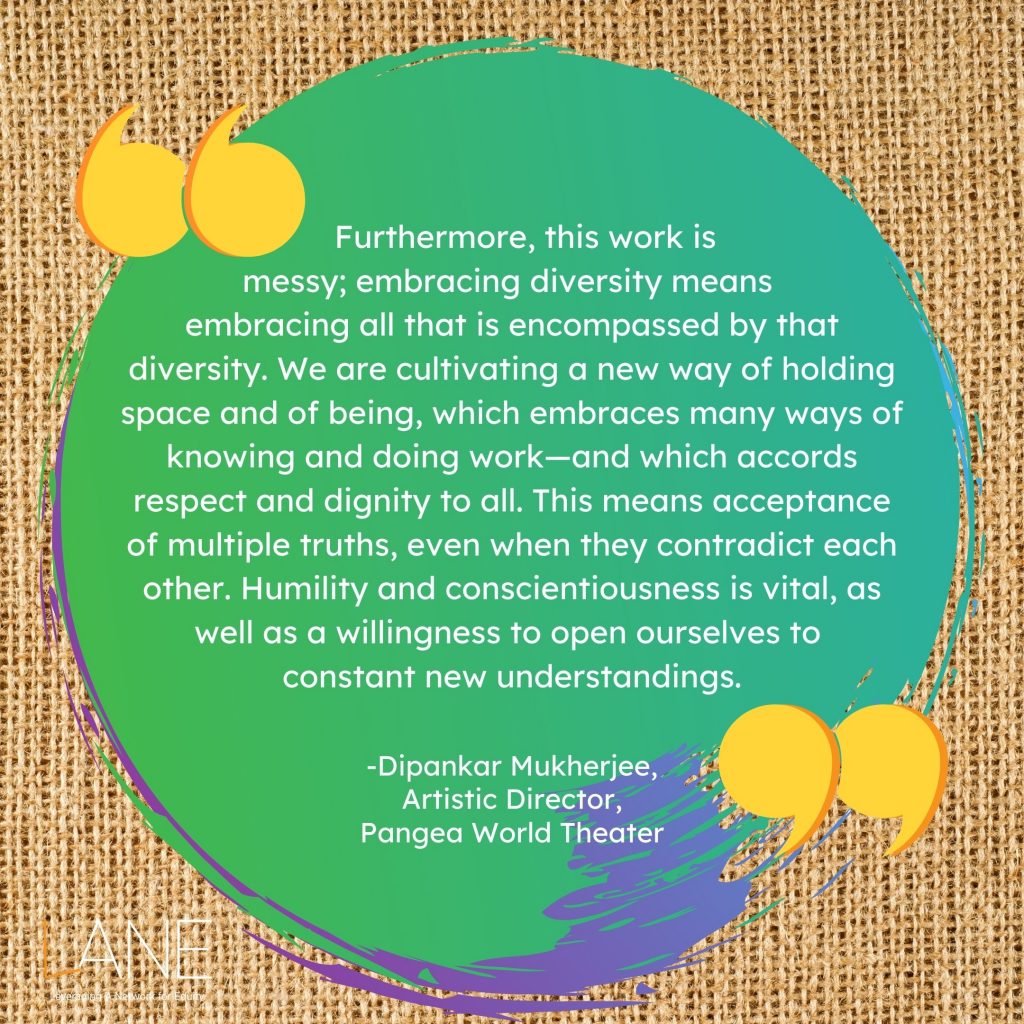
Aug 10 (1 of 3)
“Furthermore, this work is messy; embracing diversity means embracing all that is encompassed by that diversity. We are cultivating a new way of holding space and of being, which embraces many ways of knowing and doing work—and which accords respect and dignity to all. This means acceptance of multiple truths, even when they contradict each other. Humility and conscientiousness is vital, as well as a willingness to open ourselves to constant new understandings.”
—Dipankar Mukherjee, Artistic Director, Pangea World Theater

Aug 10 (2 of 3)
In order to hold multiple perspectives, we must engage power in relationships. Story Circles are a tool that reorganizes power inside communities to ensure that all voices have a role in the shaping of their material conditions.
“The rules of the story circle are the rules of civil participation in society. You agree to listen. You agree to respect.”
—John O'Neal, founder of Junebug Productions and co-founder of Free Southern Theater.

Aug 10 (3 of 3)
More on stories as tools for liberation:
- Story Circle Discussion Paper – Junebug Productions
- Lake Street Story Circle – Pangea World Theater
- A Conversation with John O'Neal

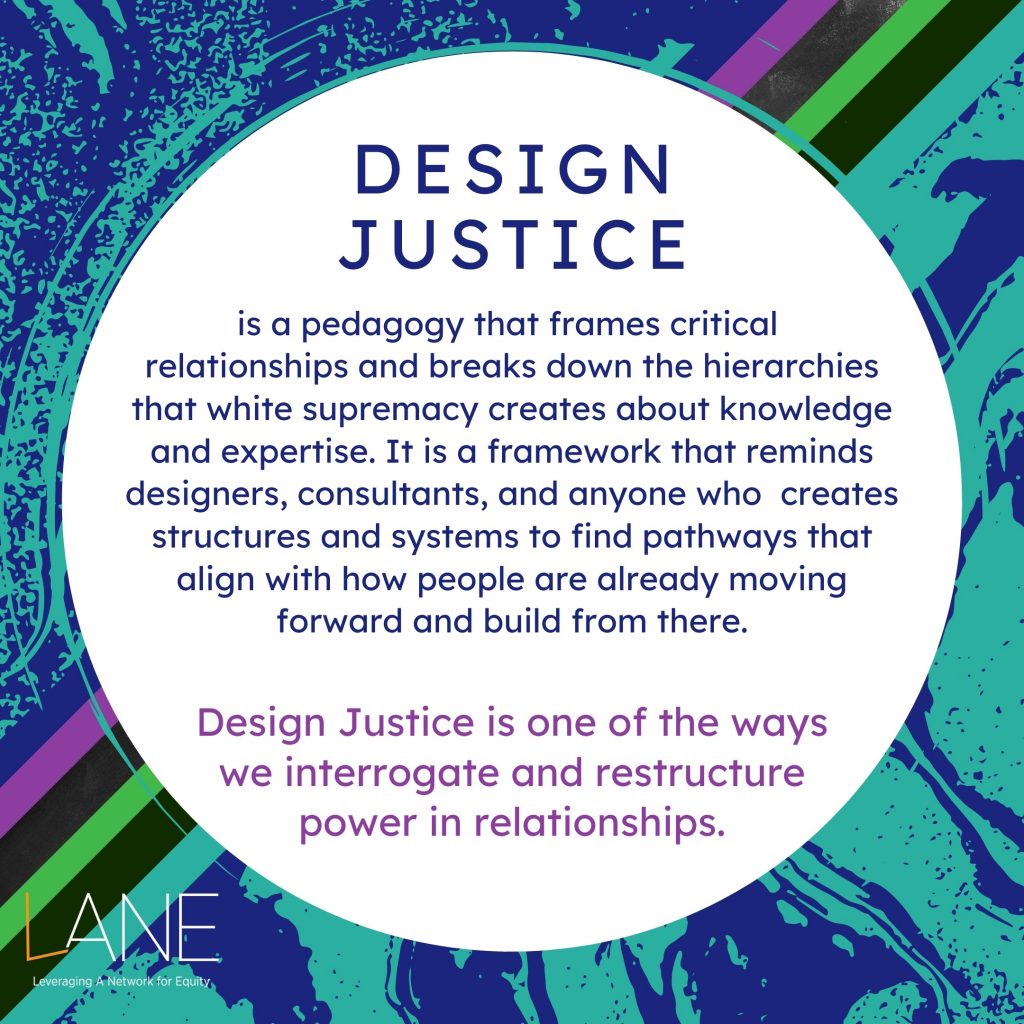
Aug 11 (1 of 3)
Every Tuesday of Black August, we will feature one of the Cornerstones of LANE. The Cornerstones are the guiding principles that frame and shape how the work of shifting towards an arts culture of justice and equity happens.
Design Justice is a pedagogy that frames critical relationships and breaks down the hierarchies that white supremacy creates about knowledge and expertise. It is a framework that reminds designers, consultants, and anyone who creates structures and systems to find pathways that align with how people are already moving forward and build from there. Design Justice is one of the ways we interrogate and restructure power in relationships.

Aug 11 (2 of 3)
“In a kind of conventional capitalist design process, the benefits disproportionately flow towards the people with the most power in the situation. And the harms are, the risks are, disproportionately borne by the people who have the least amount of power. So design justice hopes to distribute the risks and the rewards more equitably.”
—Una Lee, Creative Director of And Also Too and Steering Committee member of Design Justice Network

Aug 11 (3 of 3)
Follow these links to learn more about design justice and how it can guide how you build with your communities and constituents:
- TACtile: Design Justice with Una Lee
- Una Lee’s Work and Bio – And Also Too
- Design Justice Network Principles – Design Justice Network


Aug 12 (1 of 3)
Graphic recordings developed at LANE gatherings by drawnversation

Aug 12 (2 of 3)
“The social fabric of our small town serves as a context for contemporary art making. Community organizing is used as a model for developing programs, and the CCA (Coleman Center for the Arts) participant audience has a direct voice in how cultural resources are directed. Visiting artists collaborate directly with residents to conceptualize and realize projects. Conversations about public space led to the transformation of blighted property into a public theater; public requests for community composting led to a series of artist-designed community garden plots.”
—Jackie Clay, Executive Director, Coleman Center for the Arts

Aug 12 (3 of 3)
These resources share how community can be engaged and activated to ensure collective health and wellbeing.
Here are examples of how design justice can be applied in different ways, in an art center and in communities in general:


Aug 13 (1 of 3)
“We were able to practice design justice due the sustained support of the initiative itself. Two years allowed opportunities to stay with the complexity of whatever arose.”
—Angela Lee, Executive Director, Hayti Heritage Center

Aug 13 (2 of 3)
How can design justice help you share power and deepen relationships?
Pictured: LANE Beta Cohort, September 2017
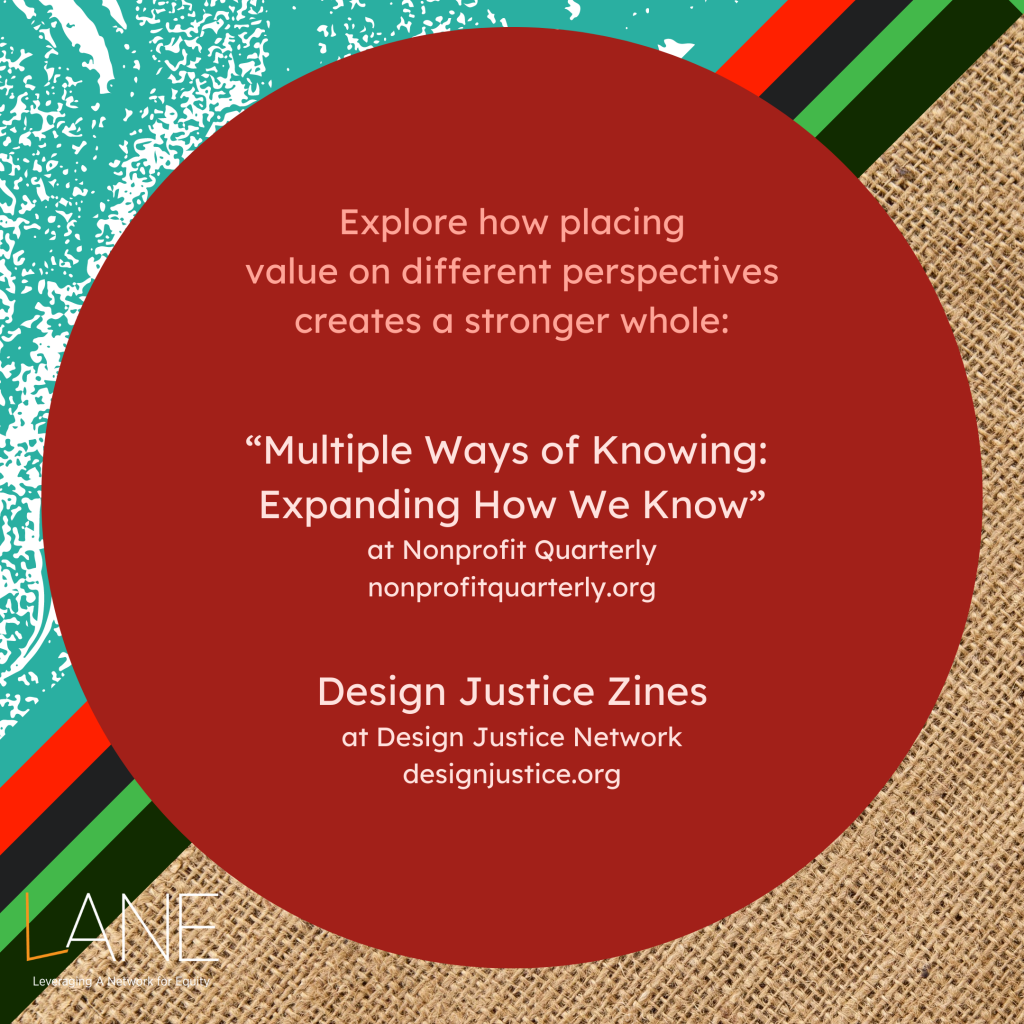
Aug 13 (3 of 3)
Explore how placing value on different perspectives creates a stronger whole:
- “Multiple Ways of Knowing: Expanding How We Know” – Nonprofit Quarterly
- Design Justice Zines – Design Justice Network


Aug 14 (1 of 3)
Graphic recordings developed at LANE gatherings by drawnversation

Aug 14 (2 of 3)
“Normally I'm used to providing the leadership. But this was a little different, the exercise of listening and trying to hear what other people are saying. ‘Cause in a lot of ways, when you listen to people and you hear what they're saying, they express their reservations, their fears, and it provided an opportunity for us to help work through that.”
—LANE Consultant


Aug 15 (1 of 1)
“This means that we are going to have to learn to think in radical terms. I use the term radical in its original meaning—getting down to and understanding the root cause. It means facing a system that does not lend itself to your needs and devising means by which you change that system.”
—Ella Baker
Learn more about Ella Baker:
- Ella Baker and the Black Freedom Movement: A Radical Democratic Vision by Barbara Ransby (University of North Carolina Press, 2003)
- “Who Was Ella Baker?” — Ella Baker Center for Human Rights


Aug 17 (1 of 3)
"The greatest evil in our country today is not racism, but ignorance. I believe unconditionally in the ability of people to respond when they are told the truth. We need to be taught to study rather than to believe, to inquire rather than to affirm."
—Septima Clark, Director of Workshops, Highlander Center
Image: Bob Fitch photography archive, © Stanford University Libraries
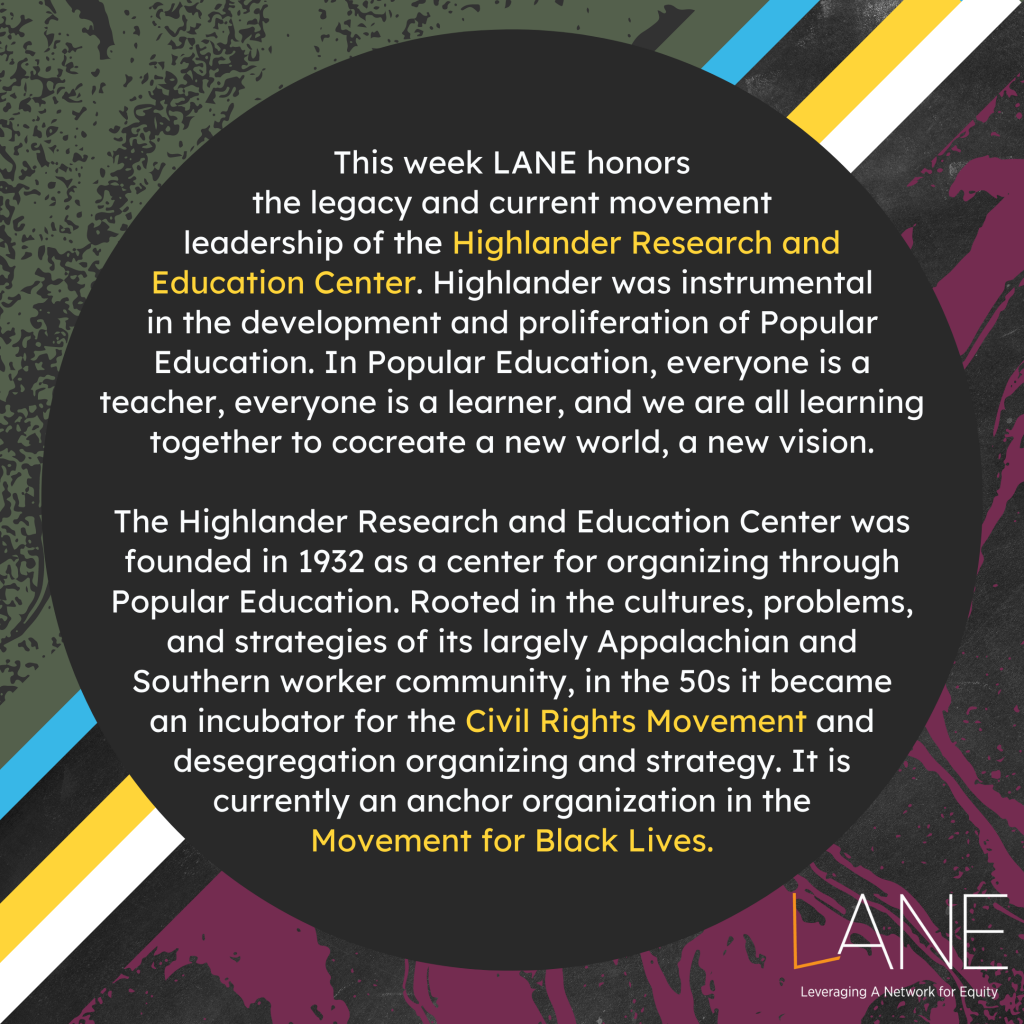
Aug 17 (2 of 3)
This week LANE honors the legacy and current movement leadership of the Highlander Research and Education Center. Highlander was instrumental in the development and proliferation of Popular Education. In Popular Education, everyone is a teacher, everyone is a learner, and we are all learning together to cocreate a new world, a new vision.
The Highlander Research and Education Center was founded in 1932 as a center for organizing through Popular Education. Rooted in the cultures, problems, and strategies of its largely Appalachian and Southern worker community, in the 50s it became an incubator for the Civil Rights Movement and desegregation organizing and strategy. It is currently an anchor organization in the Movement for Black Lives.

Aug 17 (3 of 3)
Learn more about Highlander Center’s work in popular education, participatory research, and cultural work today to advance organizations, justice, and movements.
Septima Clark Biography – SNCC Digital Gateway
“The Highlander Idea” – Jacobin Magazine
Image: Septima Clark teaching at a Citizenship School in South Carolina Sea Islands


Aug 18 (1 of 4)
Every Tuesday of Black August, we will feature one of the Cornerstones of LANE. The Cornerstones are the guiding principles that frame and shape how the work of shifting towards an arts culture of justice and equity happens. This week's Cornerstone is Popular Education.
“Popular education is an educational approach that collectively and critically examines everyday experiences and raises consciousness for organizing and movement building, acting on injustices with a political vision in the interests of the most marginalized.”
—Paulo Freire, political education theorist

Aug 18 (2 of 4)
Popular Education centers the knowledge and lived experiences of those most impacted. In this method, the people’s expertise guides cycles of critical reflection and action for liberation.
Through our cornerstone of Popular Education, we:
- Recognize that Cohort members are the experts of their experience and lead the team process
- Develop strategies and actions based on the strengths and culture of our organizations
- Recognize that solutions come from the community
- Engage radical dialects and create strategies based on root causes

Aug 18 (3 of 4)
Nothing About Us, Without Us, Is For Us poster by Ricardo Levins Morales
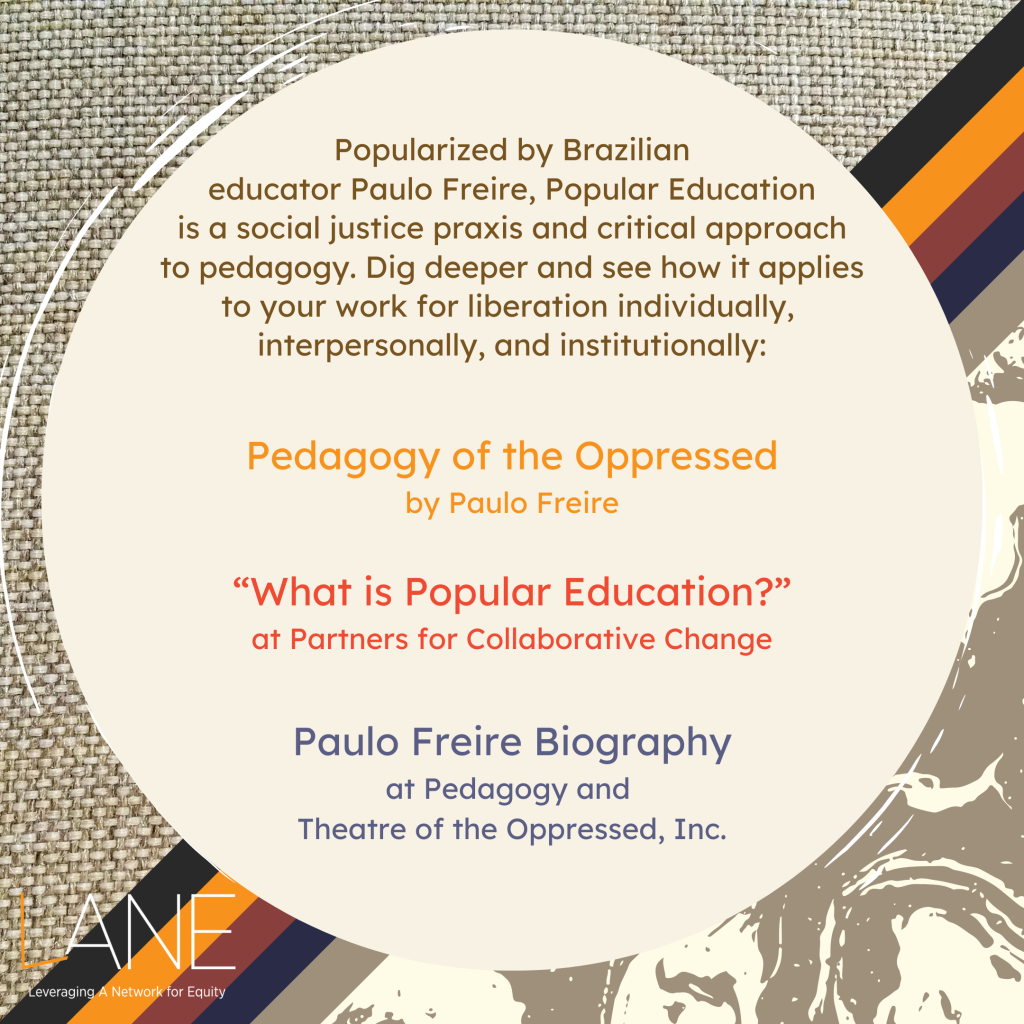
Aug 18 (4 of 4)
Popularized by Brazilian educator Paulo Freire, Popular Education is a social justice praxis and critical approach to pedagogy. Dig deeper and see how it applies to your work for liberation individually, interpersonally, and institutionally:
- Pedagogy of the Oppressed by Paulo Freire
- What is Popular Education? — Partners for Collaborative Change
- Paulo Freire Biography — Pedagogy and Theatre of the Oppressed, Inc.


Aug 19 (1 of 4)
the how of the what

Aug 19 (3 of 4)
the how of the what, designed by artist muthi reed, is a visual portal into the TACtile Popular Education Cornerstone Series conversation between Marquez Rhyne and Sage Crump. This quilted work is an engagement that is meant to be viewed as a collective and is accompanied by content that can be unlocked by visiting the related Zine.

Aug 19 (4 of 4)
The three pieces of the how of the what / TACtile Popular Education Cornerstone Series episode:
Visit:
the how of the what portal on Instagram
Read:
TACtile Popular Education Zine
Listen to the conversation:
TACTile Popular Education episode recording


Aug 20 (1 of 3)
Graphic recordings developed at LANE gatherings by drawnversation

Aug 20 (2 of 3)
“NACDI identifies and engages a broad range of cross-sector partners to advance, connect, and protect the Native community locally, regionally, and nationally. We bridge the gaps between Native communities and non-Native communities while honoring and asserting Native cultural practices and values. For us, arts, culture, and community are inextricably tied together and are directly reflective of our Native lifeways.”
—Native American Community Development Institute (NACDI), LANE Application

Aug 20 (3 of 3)
LANE’s guiding principle is See Leaders Make Change. We understand that those most impacted have the information necessary to imagine a new future—their lived experience is the most important resource. Our Cohort members are the central authors of how LANE moves in the world.
What are your practices and processes reflective of?
How does your organization consider the lived experiences of your staff? Of your community?

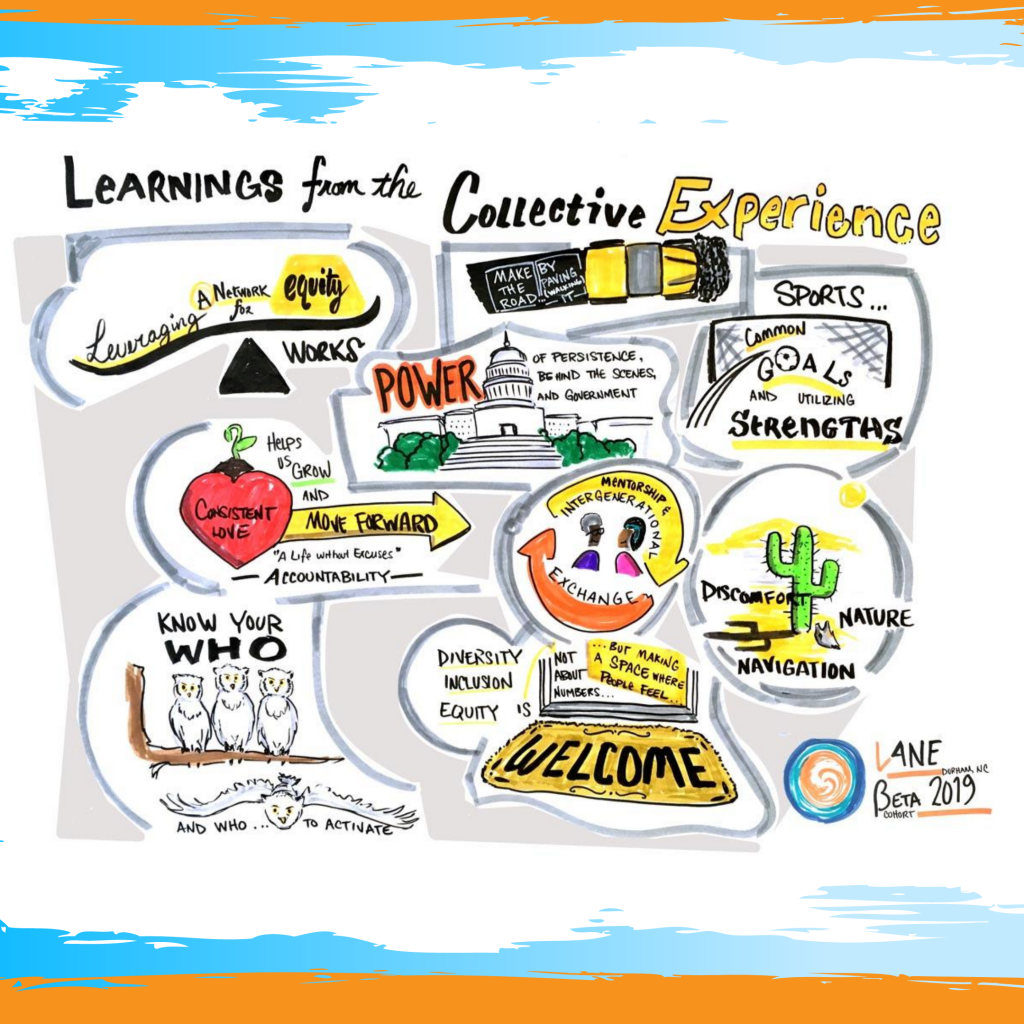
Aug 21 (1 of 4)
Graphic recordings developed at LANE gatherings by drawnversation

Aug 21 (2 of 4)
“One of our people in the Native community said the difference between white people and Indians is that Indian people know they are oppressed but don’t feel powerless. White people don’t feel oppressed, but feel powerless. Deconstruct that disempowerment. Part of the mythology that they’ve been teaching you is that you have no power. Power is not brute force and money; power is in your spirit. Power is in your soul. It is what your ancestors, your old people gave you. Power is in the earth; it is in your relationship to the earth.”
—Winona LaDuke

Aug 21 (3 of 4)
The Popular Education Spiral captures the “praxis”—the ongoing practical application—of letting people’s perspectives, strategies, and actions guide liberation. In this way, Popular Education is never linear and always informed by dialogue in which participants are experts and theorists of their experiences and needs.

Aug 21 (4 of 4)
What aspects of your organization’s work are liberatory? How can you deepen your praxis for liberation?
Curious about how popular education applies to the practice of equity and justice in the cultural sector? Read more:
- Making Sense of Cultural Equity – Createquity
- Opening remarks from Carlton Turner, founder of the Mississippi Center for Cultural Production (Sipp Culture) and former executive director of Alternate Roots, at the 2015 GIA Racial Equity Forum
- Winona LaDuke Biography – Honor the Earth


Aug 22 (1 of 1)
“We are part of each other and part of something bigger than our own egos. An artist should bring into the world some vision. They should ask, What is their work in service of?”
—Bill T. Jones
Learn more about Bill T. Jones:
- Bill T. Jones Biography – MacArthur Foundation
- “The Transcendent Artistry of a Legendary Dancer, Four Decades In” – New York Times


Aug 23 (1 of 1)
“Every artist, every scientist, every writer must decide now where he stands. The artist must take sides. He must elect to fight for freedom or for slavery. I have made my choice. I had no alternative.”
—Paul Robeson


Aug 24 (1 of 5)
The simple art of gathering around shared purpose and values is central to the rich history of racial justice and liberation struggles that Black August commemorates—and is a key component of LANE. Maroon communities living outside of slave societies, Reconstruction-era schools, the Pan African Congresses, student resistance movements, and convenings have all driven forth new institutions, new tactics, and new possibilities for cultural movements.

Aug 24 (2 of 5)
The Combahee River Collective was a Black lesbian feminist collective that practiced gathering, retreating, and group study as strategies for advancing radical Black feminist thought, culture, and political analysis. These Black artists, thinkers, and writers created a statement that outlined key issues of racial justice from a lens of intersecting oppressions.
The collective was named after the Combahee River Raid of 1863, in which Harriet Tubman, secretly enlisted by the Union army, led Black Union soldiers in a mission against the Confederate army that freed 700 enslaved people.
!['The retreats resulted in an ongoing network among those who participated in them. . . . All of a sudden, as a result of having our retreats, we suddenly had people, sometimes in our own geographic location, sometimes elsewhere, who we could reach out to, plan things with, do projects with, etc. The reason I thought of us having retreats . . . [was] because I was getting to go and meet people in various places, who were Black feminists. And I just thought, we need to kind of organize this and institutionalize this. Not in the sense of being a bureaucracy, but we need to figure out a way that the experiences I was having - because they were so valuable - and the opportunities to meet other Black feminists, we needed to do that in an organized fashion.' -Barbara Smith, Combahee River Collective](https://npnweb.org/wp-content/uploads/aug-24-B-1024x1024.png)
Aug 24 (3 of 5)
“The retreats resulted in an ongoing network among those who participated in them. . . . All of a sudden, as a result of having our retreats, we suddenly had people, sometimes in our own geographic location, sometimes elsewhere, who we could reach out to, plan things with, do projects with, etc. The reason I thought of us having retreats . . . [was] because I was getting to go and meet people in various places, who were Black feminists. And I just thought, we need to kind of organize this and institutionalize this. Not in the sense of being a bureaucracy, but we need to figure out a way that the experiences I was having—because they were so valuable—and the opportunities to meet other Black feminists, we needed to do that in an organized fashion.”
—Barbara Smith, Combahee River Collective

Aug 24 (4 of 5)
“It has been amazing to have thought partners . . . because the spinning of ideas bolsters the work and provides the engine that keeps each of our organizations moving forward. Moving through this process in cooperation and collaboration with others boosts thinking, morale, analytical rigor and creativity. Being in community with peers reinforces and inspires the analysis that is a constant in our daily organizational work.”
—Su Teatro, LANE Year 1 Reflection

Aug 24 (5 of 5)
Learn more about the Black radical tradition of organizing in the margins:
- Combahee River Collective Statement – Black Past
- How We Get Free by Keeyanga Yamatta-Taylor (Haymarket Books, 2017)
- Black August: A Feminist, Queer Syllabus for Black Liberation – Autostraddle


Aug 25 (1 of 4)
“Equity is about resource redistribution, which doesn’t get us into a conversation that is outside racialized capitalism, but justice does.”
—Wesley Taylor, professor, artist, and cofounder of Emergence Media
Check out the new TACtile Cornerstone Episode on Racial Justice with Wesley Taylor

Aug 25 (2 of 4)
Every Tuesday of Black August, we feature one of the Cornerstones of LANE. The Cornerstones are the guiding principles that frame and shape how the work of shifting towards an arts culture of justice and equity happens. This week's Cornerstone is Racial Justice and Cultural Equity.
Racial Justice and Cultural Equity seek to transform civic, cultural, and political power from an awareness of histories of racial and cultural oppression, emphasizing the cultural expressions, perspectives, experiences of oppressed and marginalized groups as essential for social transformation.
Through our cornerstone of Racial Justice / Cultural Equity, we:
- Take a historical perspective of current-day challenges
- Center the leadership of the most marginalized
- Recognize race as a primary compounding factor in oppression

Aug 25 (3 of 4)
“Cultural equity is about ensuring that the marginalized can make and circulate their images, songs, and stories, and that these can be seen, heard, read, and experienced by everyone—at minimum, it is about equal access to creativity and distribution.
This means rethinking the institutions to open them up to all—it is necessary but not enough to include more voices from different backgrounds. We need to move institutions away from being mere containers for culture that people are herded into, and to transform them into catalysts for creativity that people feel ownership of and responsibility for.”
—Jeff Chang, Vice President of Narrative, Arts, and Culture at Race Forward, from “Future Aesthetics”

Aug 25 (4 of 4)
Racial justice asks us to examine historic and current biases, white advantage, and systems of oppression. These resources illuminate a racial justice lens in culture and arts work.
- We Gon’ Be Alright by Jeff Chang (Macmillan, 2016)
- Race to Lead Revisited: Obstacles and Opportunities in Addressing the Nonprofit Racial Leadership Gap – Building Movement Project
- Paying Attention to White Culture and Privilege: A Missing Link to Advancing Racial Equity by Gita Gulati-Partee and Maggie Potapchuk


Aug 26 (1 of 4)
Cohort Member Pangea World Theater has been hosting a series of conversations and writing about the state of the world and how cultural workers can be engaged in deep change. Subscribe here!
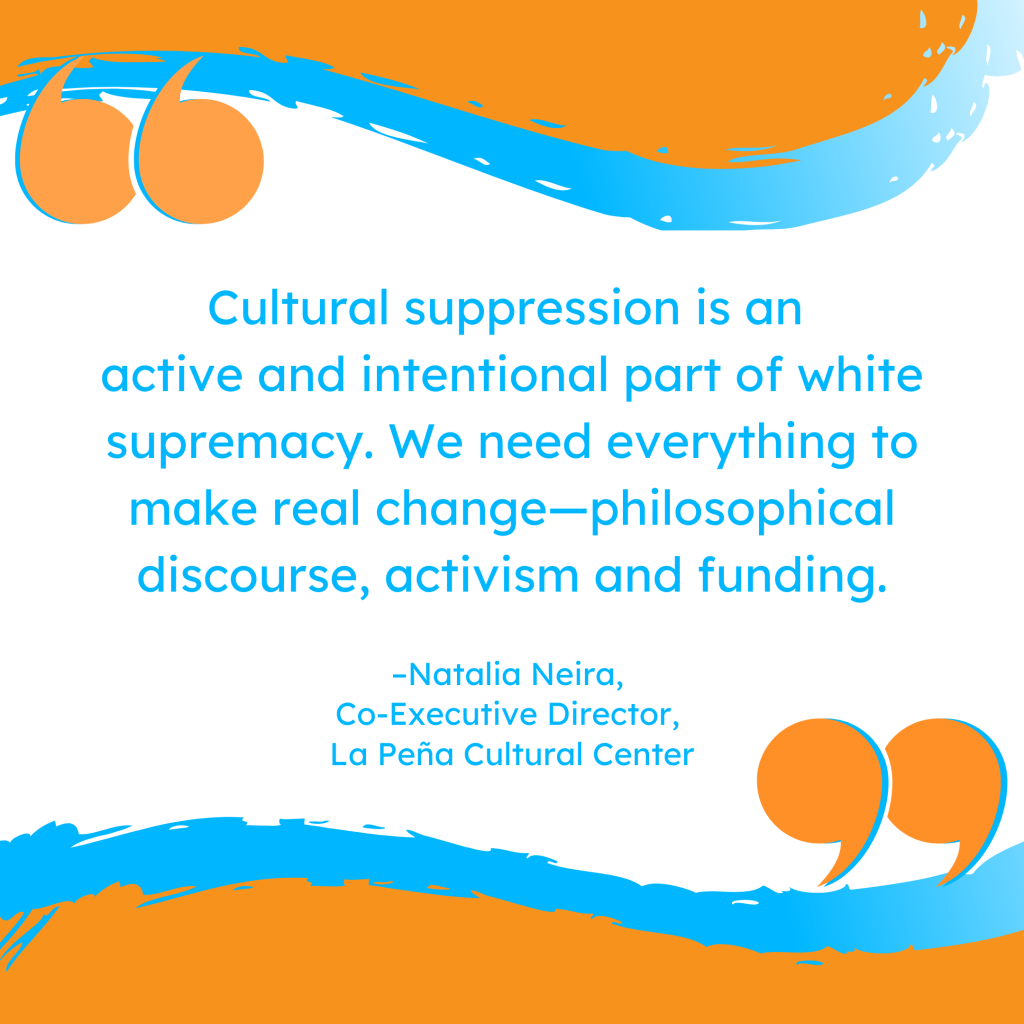
Aug 26 (2 of 4)
“Cultural suppression is an active and intentional part of white supremacy. We need everything to make real change—philosophical discourse, activism and funding.”
—Natalia Neira, Co-Executive Director, La Peña Cultural Center

Aug 26 (3 of 4)
“We explored how Native values around communication could be reflected in the way that NACDI connects with and serves the community. We started to outline the ways NACDI could connect with the community and engage a feedback loop that would inform NACDI’s actions that could be based on Native values.”
—Beatrice, LANE Consultant, on the Native American Community Development Institute (NACDI)

Aug 26 (4 of 4)
These resources also look forward to vision racial justice/cultural equity and back to understand how we got here:
- Placemaking When Black Lives Matter
by Annette Koh
at Project for Public Spaces - What Did Cedric Robinson Mean by Racial Capitalism?
by Robin D. G. Kelley
at Boston Review


Aug 27 (1 of 4)
“Tenets of Principled Struggle” by NTanya Lee
Be honest and direct with compassion.
Take responsibility for your feelings and actions.
Struggle to deepen understanding and unity.
Seek deeper understanding . . . Ask/Read 1st.
Consider this may or may not be the container you need.
Side conversations should build, not divide or check out . . . Can you bring this side conversation to the full group?
Racial justice is a difficult navigation for any organization. The framework of principled struggle was developed by NTanya Lee and others during the Black Radical Congress in 1998. LANE uses these principles to work through tensions that inevitably come up when we engage racial justice as organizations.

Aug 27 (2 of 4)
“The plays of a real Negro theatre must be: One: About us. That is, they must have plots which reveal Negro life as it is. Two: By us. That is, they must be written by Negro authors who understand from birth and continual association just what it means to be a Negro today. Three: For us. That is, the theatre must cater primarily to Negro audiences and be supported and sustained by their entertainment and approval. Four: Near us. The theatre must be in a Negro neighborhood near the mass of ordinary Negro people.”
—W. E. B. Du Bois

Aug 27 (3 of 4)
“I want to see the transformation of the nonprofit model based on a bottom up construct – building on the wisdom and political savvy that communities of color have been developing for centuries. I would like for us to own as a country all of the dimensions of our past and present and to construct a new narrative where we openly examine colonialism – neocolonialism, racism etc, so that we can truly understand how these underlying systems still guide the major aspects of our economy and politics and thus our culture.”
—Tanya Mote, Associate Director, Su Teatro

Aug 27 (4 of 4)
How can your art and culture work respond to the question of freedom for historically oppressed groups?
What might it look like for organizations to center work that is about, by, for, and near racially oppressed communities?
How can we navigate the tensions of racial justice in a principled way?
These resources make connections between racial justice, cultural equity, and the systems surrounding them.
- The Case for Reparations by Ta-Nehisi Coates
- What is Systemic Racism? – Race Forward


Aug 28 (1 of 4)
This graphic recording captures the Beta Cohort’s collective vision of the culture of LANE.
Graphic recording by Studio Thalo.

Aug 28 (2 of 4)
As a part of an ongoing, multitiered, and participatory assessment of LANE, Cohort members explored what they want the culture of LANE to be.
Exercise:
Each individual writes a word or phrase that reflects their vision for the culture of the organization. Then work in small groups to join your words into cohesive statements.

Aug 28 (3 of 4)
This recording captures the Alpha Cohort’s reflections around the question: “How do we collectively impact our cities, communities, and the field of arts and culture?”
Graphic recording by RogueMark Studios.
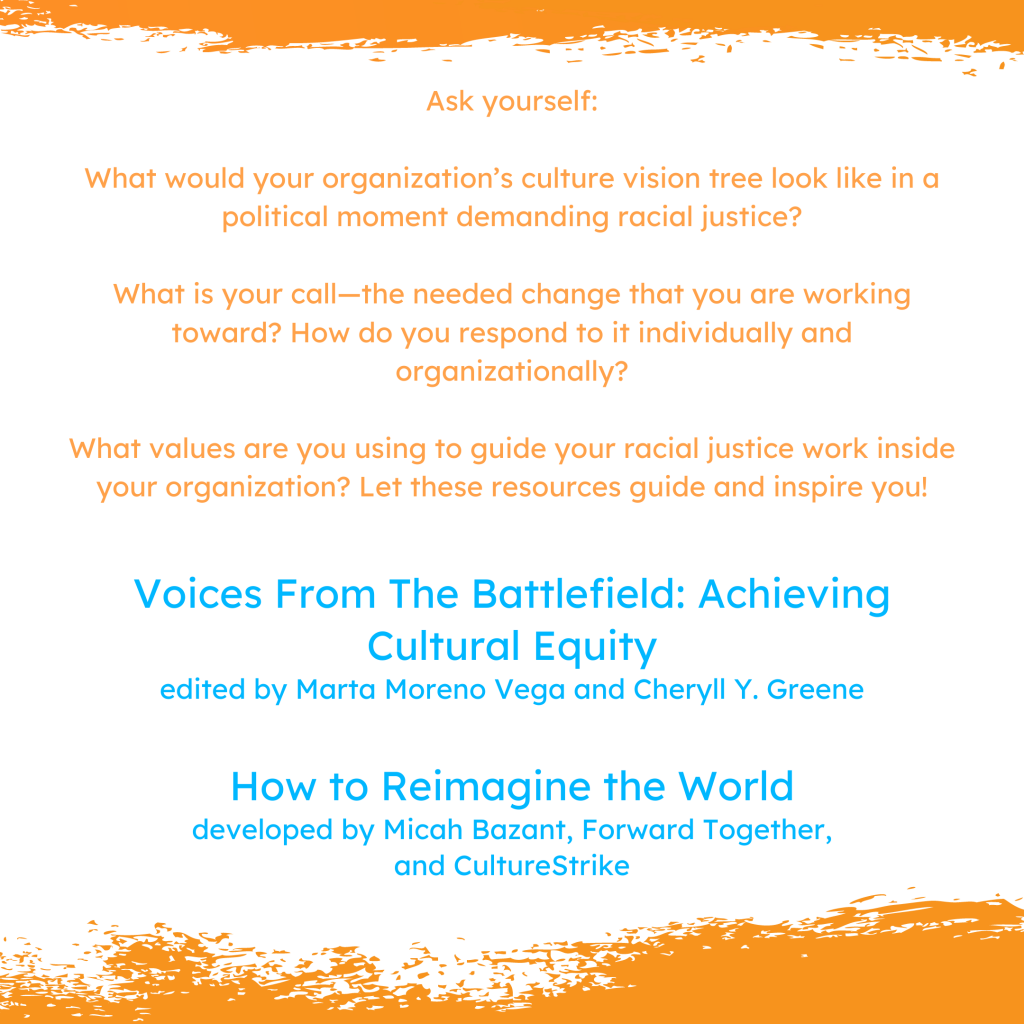
Aug 28 (4 of 4)
Ask yourself:
What would your organization’s culture vision tree look like in a political moment demanding racial justice?
What is your call—the needed change that you are working toward? How do you respond to it individually and organizationally?
What values are you using to guide your racial justice work inside your organization? Let these resources guide and inspire you!
- Voices From The Battlefield: Achieving Cultural Equity edited by Marta Moreno Vega and Cheryll Y. Greene (Africa Word Press, 1993)
- How to Reimagine the World, developed by Micah Bazant, Forward Together, and CultureStrike


Aug 29 (1 of 1)
“The function, the very serious function of racism is distraction. It keeps you from doing your work. It keeps you explaining, over and over again, your reason for being. Somebody says you have no language and you spend twenty years proving that you do. Somebody says your head isn’t shaped properly so you have scientists working on the fact that it is. Somebody says you have no art, so you dredge that up. Somebody says you have no kingdoms, so you dredge that up. None of this is necessary. There will always be one more thing.”
—Toni Morrison
Toni Morrison: The Pieces I Am film
Toni Morrison obituary – the Guardian
!['The beauty of the partnership is that each plant does what it does in order to increase its own growth. But as it happens, when the individuals flourish, so does the whole. . . . The most important thing each of us can know is our unique gift and how to use it in the world. Individuality is cherished and nurtured, because, in order for the whole to flourish, each of us has to be strong in who we are and carry our gifts with conviction, so they can be shared with others. Being among the [three plants] provides a visible manifestation of what a community can become when its members understand and share their gifts. In reciprocity, we fill our spirits as well as our bellies.' -Robin Wall Kimmerer, Braiding Sweetgrass](https://npnweb.org/wp-content/uploads/aug-30-300x300.png)
!['The beauty of the partnership is that each plant does what it does in order to increase its own growth. But as it happens, when the individuals flourish, so does the whole. . . . The most important thing each of us can know is our unique gift and how to use it in the world. Individuality is cherished and nurtured, because, in order for the whole to flourish, each of us has to be strong in who we are and carry our gifts with conviction, so they can be shared with others. Being among the [three plants] provides a visible manifestation of what a community can become when its members understand and share their gifts. In reciprocity, we fill our spirits as well as our bellies.' -Robin Wall Kimmerer, Braiding Sweetgrass](https://npnweb.org/wp-content/uploads/aug-30-1024x1024.png)
Aug 30 (1 of 1)
“The beauty of the partnership is that each plant does what it does in order to increase its own growth. But as it happens, when the individuals flourish, so does the whole. . . . The most important thing each of us can know is our unique gift and how to use it in the world. Individuality is cherished and nurtured, because, in order for the whole to flourish, each of us has to be strong in who we are and carry our gifts with conviction, so they can be shared with others. Being among the [three plants] provides a visible manifestation of what a community can become when its members understand and share their gifts. In reciprocity, we fill our spirits as well as our bellies.”
—Robin Wall Kimmerer, Braiding Sweetgrass


Aug 31 (1 of 3)
“As I examine the moment, I see a re-alignment of forces, institutionally and within a people’s movement that has the potential to move us towards the equity that we have long been denied.”
—Linda Parris Bailey, former Executive Artistic Director at Carpetbag Theatre
(from LANE application)
Pictured: LANE Cohorts, December 2019 NPN Annual Conference

Aug 31 (2 of 3)
Over the course of this month, we’ve interwoven the Cornerstones, tools, insights, and driving questions of LANE with the historical realignment and political education central to Black August.
Equity in the arts and culture ecosystem relies on our ongoing orientation and recommitment to transformation. It asks us not only to identify but also to reimagine power in our organizations and our field. We hope #BlackAugustLANE has inspired you to ask how you can use your art, your culture, your power to mainstream equity.
The resources we curated will remain available here. Thank you for reflecting and revisiting with us along the way!

Aug 31 (3 of 3)
LANE Black August was made possible through the brilliance and commitment of the following people:
LANE Cohort members and Consultants:
Content Curator – Steph de Wolfe
Graphic Designer – Alleyha Dannett
Web Design and Development - Big Tada
Communications Manager, NPN – Sara Carminati
LANE Program Specialist – Sage Crump
Former LANE Program Manager – Monica Tyran
LANE Consultants:
Kiyoko McCrae
Sham-e-Ali Nayeem
Justin Laing
Marquez Rhyne
Beatrice Thomas
Leatrice Ellzy
Kristin Sborgna
Keryl McCord









